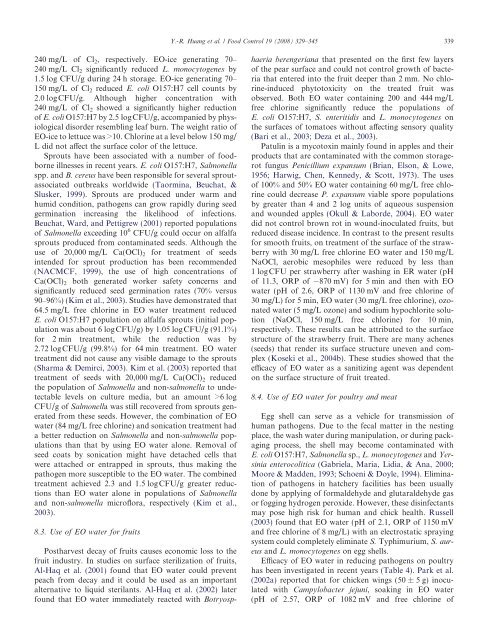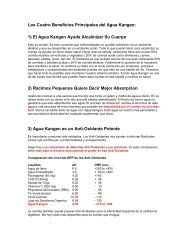ACID-ALKALINE BALANCE: ROLE IN CHRONIC ... - My Kangen Tools
ACID-ALKALINE BALANCE: ROLE IN CHRONIC ... - My Kangen Tools
ACID-ALKALINE BALANCE: ROLE IN CHRONIC ... - My Kangen Tools
You also want an ePaper? Increase the reach of your titles
YUMPU automatically turns print PDFs into web optimized ePapers that Google loves.
Y.-R. Huang et al. / Food Control 19 (2008) 329–345 339<br />
240 mg/L of Cl 2 , respectively. EO-ice generating 70–<br />
240 mg/L Cl 2 significantly reduced L. monocytogenes by<br />
1.5 log CFU/g during 24 h storage. EO-ice generating 70–<br />
150 mg/L of Cl 2 reduced E. coli O157:H7 cell counts by<br />
2.0 logCFU/g. Although higher concentration with<br />
240 mg/L of Cl 2 showed a significantly higher reduction<br />
of E. coli O157:H7 by 2.5 logCFU/g, accompanied by physiological<br />
disorder resembling leaf burn. The weight ratio of<br />
EO-ice to lettuce was >10. Chlorine at a level below 150 mg/<br />
L did not affect the surface color of the lettuce.<br />
Sprouts have been associated with a number of foodborne<br />
illnesses in recent years. E. coli O157:H7, Salmonella<br />
spp. and B. cereus have been responsible for several sproutassociated<br />
outbreaks worldwide (Taormina, Beuchat, &<br />
Slusker, 1999). Sprouts are produced under warm and<br />
humid condition, pathogens can grow rapidly during seed<br />
germination increasing the likelihood of infections.<br />
Beuchat, Ward, and Pettigrew (2001) reported populations<br />
of Salmonella exceeding 10 6 CFU/g could occur on alfalfa<br />
sprouts produced from contaminated seeds. Although the<br />
use of 20,000 mg/L Ca(OCl) 2 for treatment of seeds<br />
intended for sprout production has been recommended<br />
(NACMCF, 1999), the use of high concentrations of<br />
Ca(OCl) 2 both generated worker safety concerns and<br />
significantly reduced seed germination rates (70% versus<br />
90–96%) (Kim et al., 2003). Studies have demonstrated that<br />
64.5 mg/L free chlorine in EO water treatment reduced<br />
E. coli O157:H7 population on alfalfa sprouts (initial population<br />
was about 6 logCFU/g) by 1.05 logCFU/g (91.1%)<br />
for 2 min treatment, while the reduction was by<br />
2.72 logCFU/g (99.8%) for 64 min treatment. EO water<br />
treatment did not cause any visible damage to the sprouts<br />
(Sharma & Demirci, 2003). Kim et al. (2003) reported that<br />
treatment of seeds with 20,000 mg/L Ca(OCl) 2 reduced<br />
the population of Salmonella and non-salmonella to undetectable<br />
levels on culture media, but an amount >6 log<br />
CFU/g of Salmonella was still recovered from sprouts generated<br />
from these seeds. However, the combination of EO<br />
water (84 mg/L free chlorine) and sonication treatment had<br />
a better reduction on Salmonella and non-salmonella populations<br />
than that by using EO water alone. Removal of<br />
seed coats by sonication might have detached cells that<br />
were attached or entrapped in sprouts, thus making the<br />
pathogen more susceptible to the EO water. The combined<br />
treatment achieved 2.3 and 1.5 logCFU/g greater reductions<br />
than EO water alone in populations of Salmonella<br />
and non-salmonella microflora, respectively (Kim et al.,<br />
2003).<br />
8.3. Use of EO water for fruits<br />
Postharvest decay of fruits causes economic loss to the<br />
fruit industry. In studies on surface sterilization of fruits,<br />
Al-Haq et al. (2001) found that EO water could prevent<br />
peach from decay and it could be used as an important<br />
alternative to liquid sterilants. Al-Haq et al. (2002) later<br />
found that EO water immediately reacted with Botryosphaeria<br />
berengeriana that presented on the first few layers<br />
of the pear surface and could not control growth of bacteria<br />
that entered into the fruit deeper than 2 mm. No chlorine-induced<br />
phytotoxicity on the treated fruit was<br />
observed. Both EO water containing 200 and 444 mg/L<br />
free chlorine significantly reduce the populations of<br />
E. coli O157:H7, S. enteritidis and L. monocytogenes on<br />
the surfaces of tomatoes without affecting sensory quality<br />
(Bari et al., 2003; Deza et al., 2003).<br />
Patulin is a mycotoxin mainly found in apples and their<br />
products that are contaminated with the common storagerot<br />
fungus Penicillium expansum (Brian, Elson, & Lowe,<br />
1956; Harwig, Chen, Kennedy, & Scott, 1973). The uses<br />
of 100% and 50% EO water containing 60 mg/L free chlorine<br />
could decrease P. expansum viable spore populations<br />
by greater than 4 and 2 log units of aqueous suspension<br />
and wounded apples (Okull & Laborde, 2004). EO water<br />
did not control brown rot in wound-inoculated fruits, but<br />
reduced disease incidence. In contrast to the present results<br />
for smooth fruits, on treatment of the surface of the strawberry<br />
with 30 mg/L free chlorine EO water and 150 mg/L<br />
NaOCl, aerobic mesophiles were reduced by less than<br />
1 logCFU per strawberry after washing in ER water (pH<br />
of 11.3, ORP of 870 mV) for 5 min and then with EO<br />
water (pH of 2.6, ORP of 1130 mV and free chlorine of<br />
30 mg/L) for 5 min, EO water (30 mg/L free chlorine), ozonated<br />
water (5 mg/L ozone) and sodium hypochlorite solution<br />
(NaOCl, 150 mg/L free chlorine) for 10 min,<br />
respectively. These results can be attributed to the surface<br />
structure of the strawberry fruit. There are many achenes<br />
(seeds) that render its surface structure uneven and complex<br />
(Koseki et al., 2004b). These studies showed that the<br />
efficacy of EO water as a sanitizing agent was dependent<br />
on the surface structure of fruit treated.<br />
8.4. Use of EO water for poultry and meat<br />
Egg shell can serve as a vehicle for transmission of<br />
human pathogens. Due to the fecal matter in the nesting<br />
place, the wash water during manipulation, or during packaging<br />
process, the shell may become contaminated with<br />
E. coli O157:H7, Salmonella sp., L. monocytogenes and Yersinia<br />
enterocolitica (Gabriela, Maria, Lidia, & Ana, 2000;<br />
Moore & Madden, 1993; Schoeni & Doyle, 1994). Elimination<br />
of pathogens in hatchery facilities has been usually<br />
done by applying of formaldehyde and glutaraldehyde gas<br />
or fogging hydrogen peroxide. However, these disinfectants<br />
may pose high risk for human and chick health. Russell<br />
(2003) found that EO water (pH of 2.1, ORP of 1150 mV<br />
and free chlorine of 8 mg/L) with an electrostatic spraying<br />
system could completely eliminate S. Typhimurium, S. aureus<br />
and L. monocytogenes on egg shells.<br />
Efficacy of EO water in reducing pathogens on poultry<br />
has been investigated in recent years (Table 4). Park et al.<br />
(2002a) reported that for chicken wings (50 ± 5 g) inoculated<br />
with Campylobacter jejuni, soaking in EO water<br />
(pH of 2.57, ORP of 1082 mV and free chlorine of



